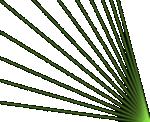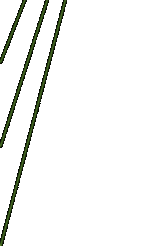|
11. Hologram
drying
Hologram
drying operation is considered in a separate lesson,
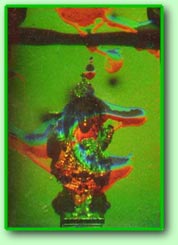 since special attention should
be paid to non-obvious processes taking place by
drying and to influence of the drying operation
on the hologram quality. It can be very pity when
after so labour-intensive work relating to recording
and chemical treatment of the hologram and after
completion of the last operation you'll see on the
hologram not good-looking colored stains and spots
which sharply worsen image quality (see photo).
And the most unpleasant point consists in the fact
that these defects are unrepairable even if you
repeat the hologram drying operation. since special attention should
be paid to non-obvious processes taking place by
drying and to influence of the drying operation
on the hologram quality. It can be very pity when
after so labour-intensive work relating to recording
and chemical treatment of the hologram and after
completion of the last operation you'll see on the
hologram not good-looking colored stains and spots
which sharply worsen image quality (see photo).
And the most unpleasant point consists in the fact
that these defects are unrepairable even if you
repeat the hologram drying operation.
You'll probably be astonished if we tell you that
as a matter of fact this operation can't be called
drying operation in the strict sense of this term.
In reality the purpose of this operation is removal
of water only from the hologram surface. And namely
the remains of water on the emulsion layer surface
cause the above-mentioned defects. Water inside
the emulsion layer evaporates gradually and doesn't
cause any harm to the hologram.
It
may seem strange but the emulsion gelatinous layer
of the photographic plate partly has hydrophobic
properties - it repels water. You can easily make
sure of this while looking how water flows down
from the hologram by chemical treatment. Water is
gathered into separate streams and drops which remain
on the photographic plate surface even if you keep
it vertically over the tray. Mechanisms of water
(and water solutions) penetration into hydrophobic
emulsion layer and deformations of the emulsion
layer by surface water drying aren't yet found out
in details but it's obvious that just the remains
of these streams and drops are the main reasons
of colored stains on the hologram.
For uniform removal of surface water it's possible
to add the so-called surface-active substances (SAS)
into water. SAS always contain in shampoos and detergents.
They increase hydrophilic properties of the emulsion
layer and facilitate water flowing down from the
photographic plate. But this process proceeds slow
(it takes several hours) and drying quality is heavily
deteriorated because of dust particles, small glass
splinters and suspension from running water which
stick to emulsion layer surface. Colored stains
inevitably appear around every such small particle.
More rapid and reliable method of the hologram drying
is drying using ethyl alcohol. A research worker
S. Mc Grew was one of the first who paid attention
to peculiarities of alcohol drying of holograms
on dichromated gelatin (DCG). He discovered that
the alcohol penetrating into emulsion layer displaces
water from it (this process is called "dehydratation")
only in the direct vicinity from the emulsion layer
surface. As though a thin "crust" of dry
gelatin is formed which prevents going out and evaporation
of water located inside the emulsion layer. This
circumstance promotes carrying-out high-quality
hologram drying.
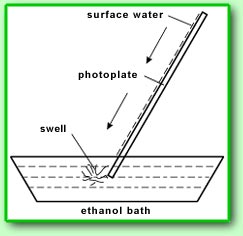 For alcohol saving three alcohol
solutions with 50%, 80% and 100% alcohol concentration
are usually used. Accurately take a photographic
plate from the tray with running water and after
water flowing down place it into the tray with 50%
alcohol solution. For removal of surface water raise
one edge of the hologram from the tray under angle
of 40-50 degrees and let alcohol flow down during
10-15 seconds. Alcohol drags water behind it from
the photographic plate surface. If you use trays
of transparent plastic you can see faint transparent
inhomogeneities - swells (see photo) near the lower
edge of the hologram. This is water flowed down
from the photographic plate and not yet dissolved
in alcohol. Having raised the photographic plate
out of the tray 4-5 times in such a way you can
make certain that the number of strias becomes progressively
less - that is water leaves the photographic plate
surface. This procedure is repeated in every tray
successively raising alcohol concentration. For alcohol saving three alcohol
solutions with 50%, 80% and 100% alcohol concentration
are usually used. Accurately take a photographic
plate from the tray with running water and after
water flowing down place it into the tray with 50%
alcohol solution. For removal of surface water raise
one edge of the hologram from the tray under angle
of 40-50 degrees and let alcohol flow down during
10-15 seconds. Alcohol drags water behind it from
the photographic plate surface. If you use trays
of transparent plastic you can see faint transparent
inhomogeneities - swells (see photo) near the lower
edge of the hologram. This is water flowed down
from the photographic plate and not yet dissolved
in alcohol. Having raised the photographic plate
out of the tray 4-5 times in such a way you can
make certain that the number of strias becomes progressively
less - that is water leaves the photographic plate
surface. This procedure is repeated in every tray
successively raising alcohol concentration.
Immediately after termination of drying process
in a 100% alcohol it's possible to remove easily
the adhered small particles from the photographic
plate surface using a small soft brush wetted in
alcohol. This would be totally impossible before
alcohol drying. The rigid "crust" prevents
damage of gelatin layer. Begin to remove particles
moving from the upper edge of the hologram to the
lower edge following alcohol flowing down. Remove
only the biggest particles since very small particle
aren't visible on the hologram after alcohol drying
up. Nevertheless be very careful by removal of glass
splinters. The fact is that a touch of the brush
can lead to a deeper penetration of the sharp glass
splinter into gelatin layer. Therefore if the splinter
can't be removed after several attempts leave it
at its place. After alcohol drying up it possibly
will create a hardly noticeable point on the hologram.
After removal of small particles place the photographic
plate on the filter paper or ordinary tissue paper
under an angle. So the second step of drying process
begins - evaporation of water from the emulsion
layer. 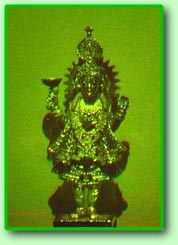 This process is slowed down
through existence of dry "crust" but since
there is already no surface water and since the
volume of this water considerably exceeded water
volume inside the emulsion layer duration of the
drying process doesn't exceed half an hour. This process is slowed down
through existence of dry "crust" but since
there is already no surface water and since the
volume of this water considerably exceeded water
volume inside the emulsion layer duration of the
drying process doesn't exceed half an hour.
Image gradually appears on the hologram. More exactly
it is transformed from the infrared spectral region
into visible spectral region as the thickness of
the emulsion layer loosing water returns to the
original state. But the final image color won't
be red as laser radiation color any longer but will
be within the limits from orange to green color
depending on the humidity level in the room and
on the degree of the emulsion layer tanning. This
effect is connected with the fact that after fixing
and removal of not developed silver bromide the
emulsion layer thickness decreased slightly. Now
the hologram is ready for final decoration (see
photo).
References
1. S.P. Mc Grew "Color control in dichromated
gelatin reflection holograms", SPIE, v. 215,
1980, p.24-31.
2. S. Vorobyov "The sensitization of VR-P Russian
photoplates for recording pulsed holograms",
SPIE, v. 3358, 1997, p.67.
-->
|
